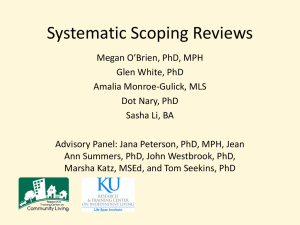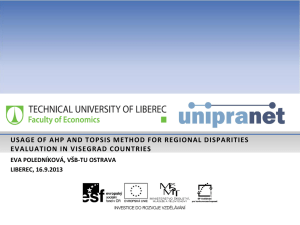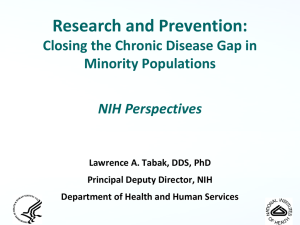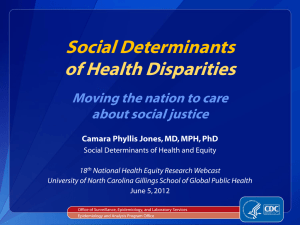TranslatingEpidIntoActionOnDisparities-201305
advertisement
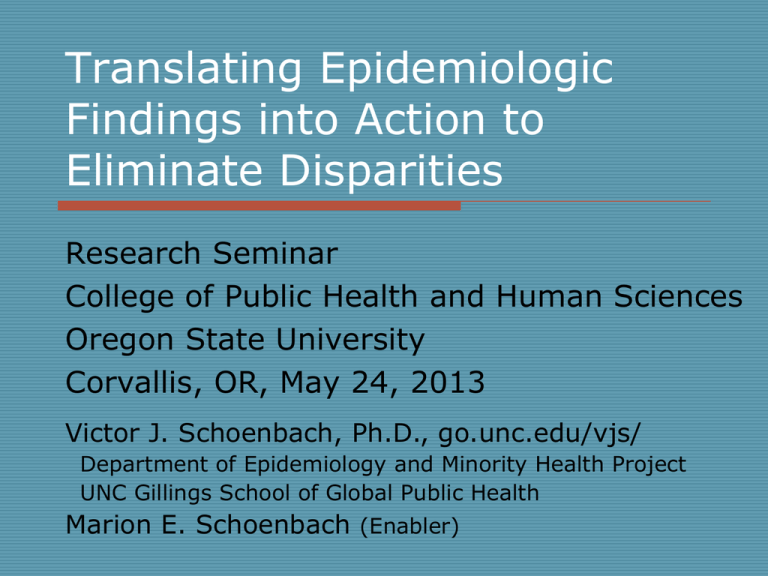
Translating Epidemiologic Findings into Action to Eliminate Disparities Research Seminar College of Public Health and Human Sciences Oregon State University Corvallis, OR, May 24, 2013 Victor J. Schoenbach, Ph.D., go.unc.edu/vjs/ Department of Epidemiology and Minority Health Project UNC Gillings School of Global Public Health Marion E. Schoenbach (Enabler) Outline The movement to eliminate health disparities Strategic plans and progress Translating epidemiologic knowledge into public health action on disparities Propositions about human behavior Challenges for epidemiology Secretary’s Task Force on Black & Minority Health, 1985 Useful landmark Heckler Report Minorities experience 60,000 excess deaths Eight main recommendations calling for outreach, cultural awareness, coordination, health care access, data, research Report of the Secretary’s Task Force "Despite the unprecedented explosion in scientific knowledge and the phenomenal capacity of medicine to diagnose, treat, and cure disease, Blacks, Hispanics, Native Americans, and those of Asian/Pacific Islander heritage have not benefited fully or equitably from the fruits of science or from those systems responsible for translating and using health sciences technology.“ (Introduction and Overview) ACE 10th Annual Scientific Meeting, 1991 in Atlanta, GA Morbidity/Mortality Gap Is it Race or Racism?” A consciousness-raising experience Healthy People 2010 Overarching goals: Goal 1: Increase Quality and Years of Healthy Life Goal 2: Eliminate Health Disparities Healthy People 2020: overarching goals 1. Attain high quality, longer lives free of preventable disease, disability, injury, and premature death. 2. Achieve health equity and eliminate disparities. 3. Create social and physical environments that promote good health for all. 4. Promote quality of life, healthy development, and healthy behaviors across all life stages. Outline The movement to eliminate health disparities Strategic plans and progress Translating epidemiologic knowledge into public health action on disparities Propositions about collective behavior Challenges for epidemiology NIH Strategic Research Plan and Budget to Reduce and Ultimately Eliminate Health Disparities “Over the last two decades the overall health of the Nation has improved significantly. Yet there continue to be striking disparities in the burden of illness and death experienced by African Americans, Hispanics, Native Americans, Alaska Natives, Asians, and Pacific Islanders. …. These disparities are believed to be the result of the complex interaction among biological factors, the environment, and specific health behaviors. Inequalities in income and education also appear to underlie many health disparities in the United States.” NIH Strategic Research Plan and Budget to Reduce and Ultimately Eliminate Health Disparities (con’t) “In fiscal year 2001, the NIH spent over $2 billion on research, research infrastructure, and public information and community outreach efforts to reduce health disparities. This provided a strong basis for further investments over the longer term – investments that promise substantial progress in reducing the incidence, prevalence, severity, and social and economic burdens of diseases and disabilities that affect racial and ethnic minorities and other health disparity populations.” NIH Health Disparities Strategic Plan, Fiscal Years 2004-2008 “Medical and scientific advances have introduced new opportunities for the continued improvement of health for all Americans. However, in spite of notable improvements gained as a result of the advancement of knowledge through basic and applied research, diagnostics, and treatment, there continues to be an alarming disproportionate burden of illness among minority and medically underserved populations.” NIH Health Disparities Strategic Plan, Fiscal Years 2004-2008 (con’t) “In fiscal year 2003, the NIH spent over $2 billion on research, research infrastructure, and public information and community outreach efforts to reduce health disparities. This provided a strong basis for further investments over the longer term - investments that promise substantial progress in reducing the incidence, prevalence, severity, and social and economic burdens of diseases and disabilities that affect racial and ethnic minorities and other health disparity populations.” NIH Health Disparities Strategic Plan and Budget Fiscal Years 2009-2013 ”As long as even one of our fellow Americans encounters barriers to optimal care – whatever the reason – our work is unfinished.” Healthy People 2010 Final Review: Changes in health disparities “most of the population-based objectives (Healthy People 2010 Final Review) with data to measure disparities had no change in health disparities.” How Far Have We Come in Reducing Health Disparities?: Progress Since 2000 Recurring themes from an April 8, 2010 Institute of Medicine workshop: Health disparities are not going away Economic hardship is an important contributor Institutional racism and racial discrimination persist Residential segregation, community environment Low levels of awareness among general public Policies of federal agencies besides those directly related to health Community input/initiation is key The Affordable Care Act should help Department of Health and Human Services Summits “The 2012 Science of Eliminating Health Disparities Summit is an HHS-wide endeavor involving a broad spectrum of the federal government that seeks to advance activities to eliminate health disparities. The agenda will build on the momentum of the 2008 Summit and the increased interest of federal agencies to demonstrate their commitment towards improving the health of all Americans. The 2012 Health Disparities Summit represents an ongoing focus on emerging science and its intersection with practice and policy, while maintaining momentum on current national and international trends in addressing the social determinants of health.” http://www.nimhd.nih.gov/summit_site/about.html Outline The movement to eliminate health disparities Strategic plans and progress Translating epidemiologic knowledge into public health action on disparities Propositions about collective behavior Challenges for epidemiology Eliminating a disparity through public health action: steps 1. 2. 3. 4. 5. 6. 7. Attention, advocacy Documentation, prioritization Interventions identified, evaluated Scalable, cost-effective Delivery methods identified Resources acquired and maintained Feedback and affirmation A Tale of Two Disparities Childhood immunization / measles elimination HIV/AIDS Childhood immunization / measles elimination Dual strategy: universal interventions + targeted interventions Gap in measles vaccine coverage narrowed from 15% (1985) to 6% (1992) to 2%. Risk ratio for disease among nonwhite children (vs. white) declined from 4-7 to 4 to elimination of endemic disease Elimination of Measles and of Disparities in Measles Childhood Vaccine Coverage among Racial and Ethnic Minority Populations in the United States Sonja S. Hutchins, Ruth Jiles, Roger Bernier. JID 2004;189:S146-S152 Increase in vaccine coverage and reduction of disparity Elimination of Measles and of Disparities in Measles Childhood Vaccine Coverage among Racial and Ethnic Minority Populations in the United States Sonja S. Hutchins, Ruth Jiles, and Roger Bernier JID 2004(May 1);189: S146-S152 Maintenance of parity in measles vaccine Elimination of Measles and of Disparities in Measles Childhood Vaccine Coverage among Racial and Ethnic Minority Populations in the United States Sonja S. Hutchins, Ruth Jiles, and Roger Bernier JID 2004(May 1);189: S146-S152 Elimination of measles and disparity Elimination of Measles and of Disparities in Measles Childhood Vaccine Coverage among Racial and Ethnic Minority Populations in the United States Sonja S. Hutchins, Ruth Jiles, and Roger Bernier JID 2004(May 1);189: S146-S152 Endgame: HIV/AIDS in African Americans (PBS Frontline) 1983: The CDC begins tracking breakdown of HIV by race. 1985: First Black AIDS Organizations founded 1986: First Black AIDS Conference 1986: No one of color is invited to participate in the American Public Health Association’s first session on AIDS in October 2004: HIV Becomes Leading Cause of Death for Young Black Women 2010: Congress removes ban on federal funding for needleexchange programs 2011: Congress reinstates ban on federal funding for needleexchange programs 2012: Black AIDS Institute Report Highlights High HIV Rates Blacks have a higher rate of undiagnosed HIV infections compared to other groups, according to a February. Although they make up less than 14 percent of the U.S. population, blacks make up 44 percent of all new infections. A Tale of Two Disparities Childhood immunization HIV Magnitude of problem Embedded in socio-economic Availability of interventions Cost, cost-effectiveness Use existing health care infrastructure Neutral or favorable to commercial, religious, political interests Near-term, visible, marketable impact + + ++ ++ ++ +++ ++ + + + ++ ++ ? Secretary’s Task Force, 1985 “The Task Force acknowledged that the factors responsible for the health disparity are complex and defy simplistic solutions. Health status is influenced by the interaction of physiological, cultural, psychological, and societal factors that are poorly understood for the general population and even less so for minorities.” Outline The movement to eliminate health disparities Strategic plans and progress Translating epidemiologic knowledge into public health action on disparities Propositions about human behavior Challenges for epidemiology Competition History is a record of competition and cooperation. 1st Century B.C. . 1st Century B.C. . Propositions on human behavior: looking under the hood 1. Living systems are made up of fundamental building blocks (e.g., quarks, electrons, protons, atoms, molecules) organized into organelles, cells, organs, etc. Propositions 2. Living systems replicate, diversify, compete, cooperate, invade one another, incorporate one another, combine, and evolve into systems of increasing complexity. Propositions 3. Complex living systems have nervous systems that can create the experiences of consciousness, memory, imagination, deductive logic, extrapolation, anticipation, prediction, and other mental functions. Propositions 4. These mental functions are generated by the interactions of over 100 billion individual agents (neurons), in the context of other types of cells and the factors they secrete, as well as other internal and environmental chemicophysical influences. Propositions 5. The resulting thoughts and actions, which are also influenced by perceptions and expectations of others’ thoughts and actions, are generally aimed at advancing the organism’s interests, as these are perceived by the organism and responded to by 100 billion+ agents. Propositions 6. Collaborations, organizations, governments, strategic plans, policies, legislation, enforcement actions, and everything else reflect these myriad, competing influences. Ultimately, better outcomes require that thoughts and actions reflect more accurate, efficient, coherent and integrated brain functioning. Propositions 7. Epidemiology should assign greater importance to understanding nutritional, microbiological, hormonal, environmental, behavioral, social, and institutional influences on the functioning of the nervous system and behavioral implications. Outline The movement to eliminate health disparities Strategic plans and progress Translating epidemiologic knowledge into public health action on disparities Propositions about human behavior Challenges for epidemiology Challenges for Epidemiology Epidemiology has been called “the basic science of public health”. Can epidemiology really study basic processes and fundamental determinants? Fundamental determinants Fundamental determinants of health are biological, behavioral, environmental, and health services. But health services reflect human behavior, and increasingly the environment does as well. Is human behavior – heavily influenced by biology – the fundamental determinant? Research on fairness judgments “We found that as children enter adolescence, they increasingly view inequalities reflecting differences in individual achievements, but not luck, as fair, whereas efficiency considerations mainly play a role in late adolescence.“ Fairness and the development of inequality acceptance. Ingvild Almas, Almås et al. Science 28 May 2010;328:1176-1178 The dinner that cost Bill Gates, Warren Buffett and other celebrities billions Warren Buffett and Bill Gates. Photo: Getty Some billionnaires donate to good causes, others … - Why? “This week … 40 billionaires – worth a combined $230 billion (£145 billion) – signed a "giving pledge" to donate at least 50 per cent of their wealth to good causes. It is a remarkable act of noblesse oblige, even in a country whose tradition of philanthropy is the strongest in the industrialised world.” www.telegraph.co.uk/news/worldnews/northamerica/usa /7929657/The-dinner-that-cost-Bill-Gates-WarrenBuffett-and-other-celebrities-billions.html “We have met the enemy and (s)he is us” – or is (s)he? “For a long time, it was generally assumed that many of the mental processes that make goal pursuit possible require consciousness. But in the past decade or so, the scientific study of goal pursuit has discovered that these processes can also operate without conscious awareness, and hence, human behavior may originate in a kind of unconscious will. Ruud Custers and Henk Aarts. The unconscious will: how the pursuit of goals operates outside of conscious awareness. Science 2010 (July 2);329(5987):47-… Are we losing our smarts? “The results of this study show that long working hours may be one of the risk factors that have a negative effect on cognitive performance in middle age.” 604 Long working hours and cognitive function: The Whitehall II Study. Marianna Virtanen et al. Am J Epidemiol 2009;169:596-605 Can consciousness be improved? Transcendental Meditation is attracting increasing interest. (www.davidlynchfoundation.org) “Quiet time” programs have shown great promise in urban schools with typical problems. Can epidemiologists evaluate a wholistic intervention with long-term impact? Can consciousness be improved?




